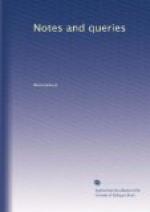Conclusion, p. 399.:
“Evidences of Christianity! I am weary of this word,” &c.
See the remarks on this passage in Archbishop Whately’s Logic, Appendix III., near the end.
The quotation from Apuleius, at the end of the book (p. 403.), is from the Metamorphos., i. 3.
J.E.B. Mayor
Marlborough College.
* * * * *
MINOR NOTES.
Capture of Henry VI. (Vol. ii., p. 181.).—There are several errors in this historical note. The name of the Dean of Windsor was Manning, not {229} “Manting;” “Brungerly” should be Bungerley. One of the Talbots, of Bashall Hall, could never be “High Sheriff for the West Riding,” as the Ridings of Yorkshire never had distinct sheriffs; neither was he sheriff of the county. The particulars of the king’s capture are thus related in the chronicle called Warksworth’s Chronicle, which has been printed by the Camden Society:—
“Also, the same yere, kynge Henry was takene byside a howse of religione [i.e. Whalley] in Lancashyre, by the mene of a blacke monke of Abyngtone [Abingdon] in a wode called Cletherwode [the wood of Clitheroe], besyde Bungerly hyppyngstones, by Thomas Talbott, sonne and heyre to sere Edmunde Talbot of Basshalle, and Jhon Talbott, his cosyne, of Colebry [i.e. Salebury, in Blackburn], withe other moo; which discryvide [him] beynge at his dynere at Wadyngton halle: and [he was] carryed to London on horsebake, and his leges bownde to the styropes.”
I have substituted the word “discryvide” for “disseyvide,” as it is printed in the Camden Society’s book, where the editor, Mr. Halliwell, understood the passage as meaning that the king was deceived or betrayed. I take the meaning to be that the black monk of Abingdon had descried, or discovered, the king as he was eating his dinner at Waddington Hall; whereupon the Talbots, and some other parties in the neighbourhood, formed plans for his apprehension, and arrested him on the first convenient opportunity, as he was crossing the ford across the river Ribble, formed by the hyppyngstones at Bungerley. Waddington belonged to Sir John Tempest, of Bracewell, who was the father-in-law of Thomas Talbot. Both Sir John Tempest and Sir James Harrington of Brierley, near Barnsley, were concerned in the king’s capture, and each received one hundred marks reward; but the fact of Sir Thomas Talbot being the chief actor, is shown by his having received the larger reward of 100L. Further particulars respecting these and other parties concerned, will be found in the notes to Warksworth’s Chronicle. The chief residence of the unhappy monarch during his retreat was at Bolton Hall, where his boots, his gloves, and a spoon, are still preserved, and are engraved in Whitaker’s Craven. An interior view of the ancient hall at Bolton, which is still remaining, is engraved in the Gentleman’s Magazine for May, 1841. Sir Ralph Pudsay, of Bolton, had married Margaret, daughter of Sir Thomas Tunstal, who attended the king as esquire of the body.




